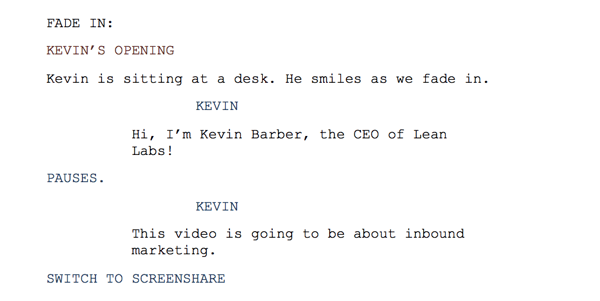A lot of teams are investing in video marketing and for good reason.
On Facebook, video posts have 135% greater organic reach.
After watching a video, viewers retain 95% of the message.
On average, users spend 88% more time on a website with video.
But by now, everyone knows the stats, right? If you haven't invested in video yet, it's probably not because you don't know the potential.
It’s probably because of concerns that come with shooting a video for the first time:
What if I stutter?
What if the camera is crooked?
What if the audio isn't right?
I've asked these questions myself. But through trial and error, I've learned enough to make pretty good videos. And if I could tell you one thing that could really help you get started, it would be one simple reminder.
Shooting Your First Online Marketing Video (And Making It Pretty Flippin’ Good)
For the most part, you're always going to be nervous. When making marketing videos, I'm still almost always a little nervous. Unless you're a pretty confident person in general, that nervousness is inevitable.
However, if you accept that anxiety will always be a part of the video process, you can embrace it. Then, you can focus on brushing up on video production best practices and preparing to the best of your ability. Your anxiety around creating "the perfect video" doesn't need to run the show.
Because your customer isn't expecting perfection from your videos. They just want them to be useful. Thus, as long as you nail the basics and focus on what your customer needs, you can create pretty customer-centric content.
Then, after you tackle the first video, you can learn from your mistakes. Here are my tips for getting it (as close) to right the first time.
1. Find A Quiet Place To Shoot
When you’re shooting a video, one of the most important decisions to make is the location. If you work in an office or live in an environment that tends to be noisy (and you have little control over that noise), I’d recommend looking at a coworking space or renting an Airbnb for this.
Because even if it doesn’t seem like that much noise, ambient sound like car horns, dogs barking, people talking and music playing will be distracting. You’ll either need to send the audio out to get fixed (which honestly, may not help the video quality that much) or completely reshoot your video later.
However, if you need to use a space with noise, do your best to control it. For example, I tend to shoot later in the day because of the background noise I can anticipate. My neighbor’s chickens tend to make noise in the early afternoon. My dog barks whenever the mail woman comes around noon. Since I know those things, I can avoid having those be issues when I shoot.
2. Use Both A Script And Storyboard
I work in community theater and have experience in film editing, so it’s not difficult for me to shoot a video without a script or a storyboard. However, when I do this, I always spend more time editing. I have to cut out unnecessary things I've said or tangents I've gone off on because I didn’t prepare enough.
If you want to shoot a video in one or two takes and have an easier time editing, you should work off a script and a storyboard. At the very least, you should have an outline. Because when you plan exactly what you’re going to say and the shots you’re going to take, you’ll have a much more polished final result. Over time, this will also help keep video production costs low.
3. Try A Few Voice And Acting Exercises Before You Shoot
In the last community theater show I did, we did voice and acting exercises before a few shows. They were basic improv exercises that helped us warm up. At the time, I felt awkward doing them, but I always felt better on stage. And it's shown me the importance of loosening up before shooting a video. Even if I take a walk or go for a run before recording, there’s a noticeable difference in my tone, pacing, and energy.
If you shoot a video when you’re in a bad mood, or when you’re feeling tired, it will always show. It’s important to be excited and upbeat. At the same time, you do want to balance the excitement and energy, so it’s not too much. Before you start shooting, I'd recommend reading through your script a few times, humming or singing, and practicing reading the lines and prompts in your voice.
4. Bluster Through It The Best That You Can
I've been nervous plenty of times, both on camera and stage. My anxiety around it almost always tries to trick me into stopping. When that happens, I just breathe and keep going. Eventually, I get through it.
In my experience, it helps to think about the expertise you’re sharing. Focus on being useful to your viewer, and the excitement should come naturally.
Alternatively, pretending there’s a friend in front of you can help you sound more conversational. You can also pretend you’re already an expert (like Neil Patel) to help you feel more at ease. Fake it 'til you make it, right?
5. Don't Sweat The Small Stuff
As long as you have a high-quality camera, a quiet space, good lighting, and know the sound is clear, shoot your video. A lot of people wait until they feel it’s the right time or chase perfection, but honestly, the best way to tackle a video is to go for it.
Even if you mispronounce a word, correct yourself in the middle of the video, knock something off your desk, or have to pause your recording, play it off. There’s a lot you can edit out later, and if you can’t, there’s nothing wrong with being human. In the end, a lot of your reviewers will probably relate to you more for it.
Aligning Video Content With Your Inbound Efforts
Once you start shooting marketing videos and building out a process, you'll ask the question: when do I start getting a return on this?
If you connect your video content to an overall inbound strategy, it won't be difficult to get a return. You can embed your video into blog posts, landing pages, and emails. However, if you don't align your videos to your ongoing marketing initiatives, it will be challenging to get good performance.
You can't share a video a few times on Facebook and expect results. Sure, you might get some views and clicks, but it won't be clear how video is getting you closer to your goals.
That's why if you don't have an inbound strategy, you should build one out before going too far with video content. Not only can you gain better ROI, you can align all of your marketing initiatives and provide a more connected, cohesive experience for your audience.






